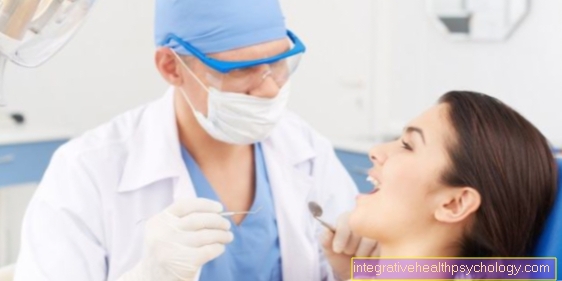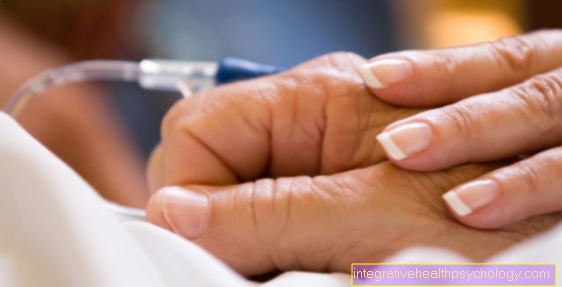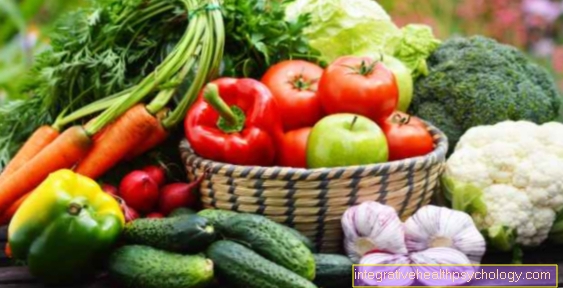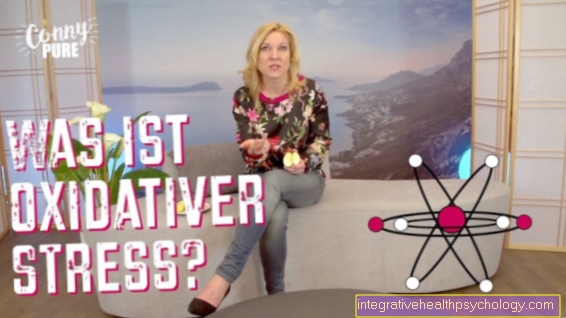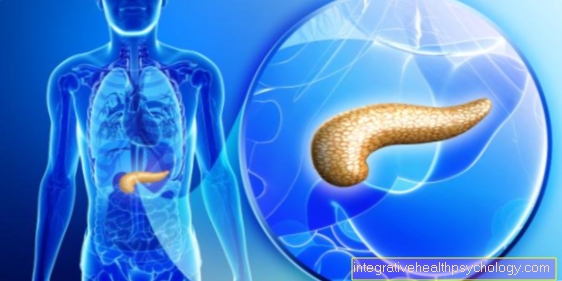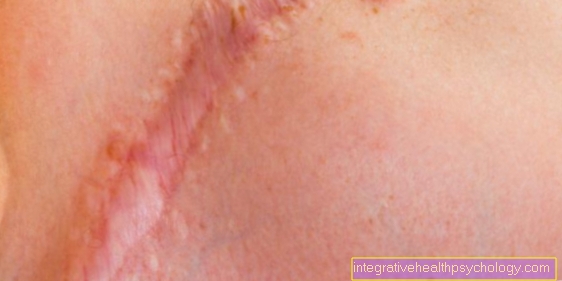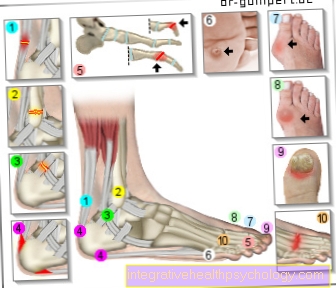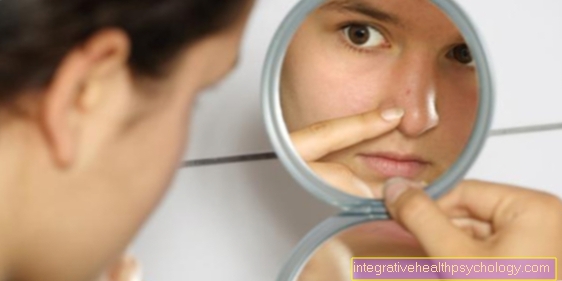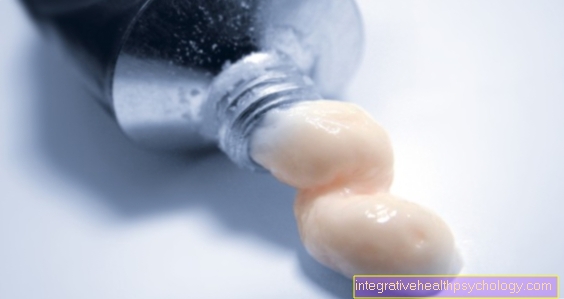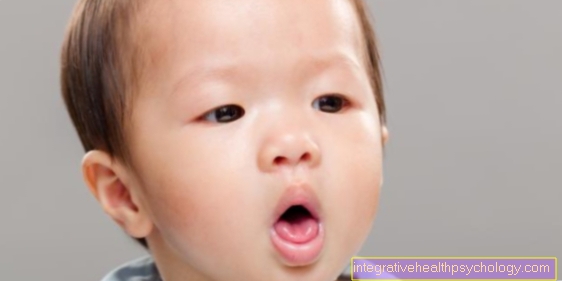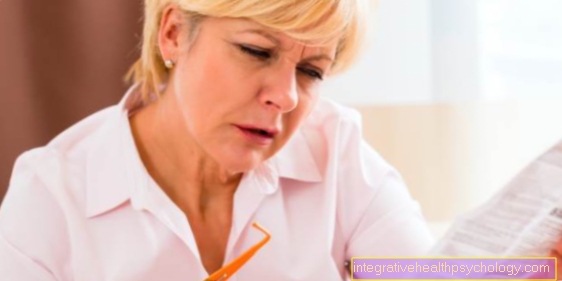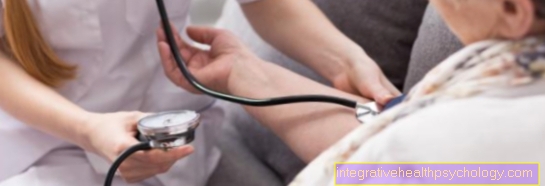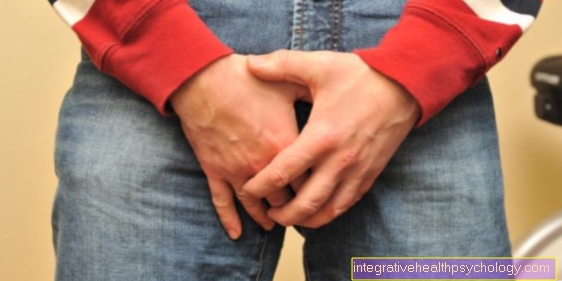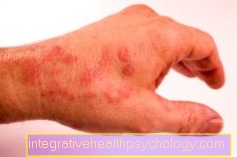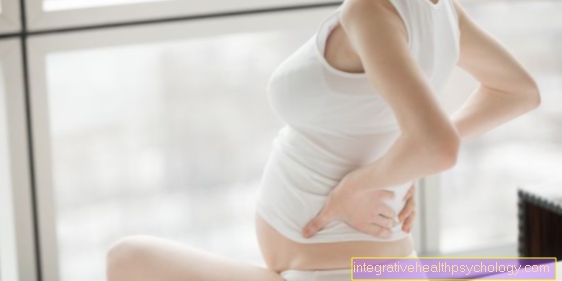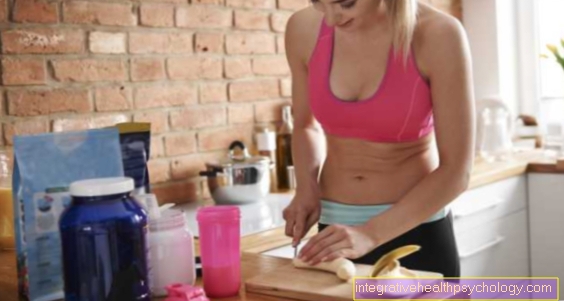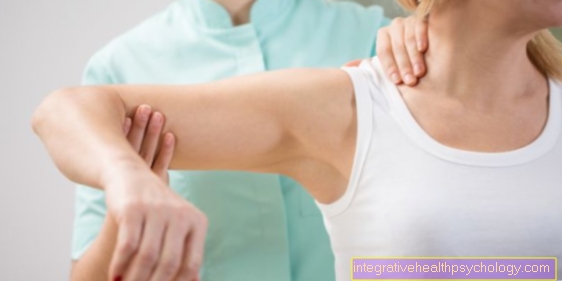Puerperal mastitis
definition
Puerperal mastitis is an inflammation of the female breast caused by bacteria and occurs during breastfeeding after pregnancy. "Mastitis" is Latin and means "inflammation of the mammary gland", whereas "Puerpera" means "puerperium". The inflammation can be stronger or weaker, depending on the causative agent and the accompanying factors. This means that the symptoms and the therapy also vary. Only mild puerperal mastitis requires patience and light home remedies, whereas severe inflammation can be very dangerous.
A distinction must be made between puerperal mastitis and non-puerperal mastitis. The latter is a little more common and refers to inflammation of the mammary gland, which is not related to pregnancy and breastfeeding. This is not described in detail in this article.
You can find more on this topic here:
- Inflammation of the mammary gland in pregnancy

causes
The cause of the inflammation of the mammary gland in puerperal mastitis are bacterial pathogens. The main trigger is the very common and not always harmful bacteria Staphylococcus aureus. Also E. coli bacteria, Streptococci and Pneumococci can cause the inflammation. In addition, there are a few factors that promote the development of inflammation. The mother's nipple becomes irritated by breastfeeding. Small cracks can appear in the nipple, especially at the beginning of the puerperium, when breastfeeding is still unfamiliar. The cracks allow bacteria from the skin or saliva of the newborn to invade the mammary glands and connective tissue of the breast. The disease occurs mainly after 2-4 weeks of breastfeeding, as breastfeeding is still unfamiliar during this time, but the germs already have enough time to multiply and spread in the breast.
Puerperal mastitis can also be differentiated into inflammation of the connective tissue and lymphatic clefts or inflammation of the milk duct system. Often there is a blockage of milk in the mammary gland during maternal breastfeeding. The milk does not flow off properly, which hardens the tissue, which only promotes the blockage of the milk. The congestion of the milk also helps the bacteria to penetrate the glands and cause inflammation.
The invading pathogens often only cause the inflammation in a certain area of the breast, where they can form encapsulated foci of inflammation. These are called an abscess. In most cases, the inflammation is in the upper and outer areas of the chest.
You might also be interested in:
- Bed sicknesses
- Postpartum fever
- Breast abscess
diagnosis
The diagnosis is easy to make by a doctor. A questioning of the exact complaints with a short physical examination by scanning the breast and the lymph nodes provides the decisive clues for the suspected diagnosis of puerperal mastitis. The breast can then be checked in a short ultrasound examination. Here the inflamed tissue can be seen well and in many cases an encapsulated abscess can already be recognized in the ultrasound.
If the symptoms do not exactly apply to puerperal mastitis, further examinations must be carried out in order to rule out any differential diagnoses. In rare cases, a breast tumor may also be present. A so-called "inflammatory breast cancer“Can cause similar symptoms with redness and swelling, but is much rarer than puerperal mastitis.
You might also be interested in:
- Recognize breast cancer
- Breast cancer risk
Concomitant symptoms
The main symptoms of puerperal mastitis consist of the five signs of inflammation. These include redness, swelling, overheating, pain but also the restricted function of the mammary gland. Palpation of the chest, if it is not too painful, can still palpate a small, hardened abscess. Often there is a congestion of the milk in the entire breast, so that the remaining, non-inflamed tissue is also hardened.
The inflammation often spreads through the lymphatic system and spreads throughout the body. The primary result is swelling lymph nodes under the armpit, which are enlarged and painful to the touch. Subsequently, a feeling of illness with weakness, fever, chills, body aches and a reduced general condition can occur throughout the body.
You may also be interested in this article: Breast pain while breastfeeding
fever
Fever is a very unspecific disease symptom that suggests an infection in the body. Fever occurs as a reaction of the body to pathogens that should be combated with the increased temperature. The body releases messenger substances at the point of inflammation, which stimulate the body to increase its temperature. A certain increased body temperature suggests an active healing process of the body, but temperatures above 40 degrees should not be exceeded as they can be harmful to the body. The fever is often accompanied by a feeling of weakness, which tells the body that it needs rest to fight the infection.
The fever indicates that puerperal mastitis is not just a small local inflammation of the breast, but a disease that affects the entire body. If the temperature rises sharply with further severe symptoms, a severe form of mastitis can also be present, in which the inflammation does not encapsulate but spreads diffusely in the body. In these cases, a doctor must be consulted, who may initiate antibiotic therapy.
Find out more about the subject of "fever" here:
- Causes of fever
- How can you measure a fever?
- How can you lower a fever?
chills
Chills are a sign of the cold. In the acute onset of the disease, chills indicate that the body has increased its own body temperature and needs warmth, which is why the environment appears cold. Typically, the onset of a fever is noticeable through sensitivity to cold surfaces, metal and outside air, as well as pain in the limbs, exhaustion and chills. After a few hours or days of the fever, the chills will subside a little when the fever temperature is reached. The fever can fluctuate over the course of the day, so that phases with chills can occur several times a day.
treatment
In most cases, mastitis can be successfully treated with simple means. To be sure, the diagnosis should be made by a doctor. Afterwards, in-house remedies can often effectively treat the mastitis. Important measures are to continue breastfeeding for the time being if you have mild mastitis, to cool the inflammation, and to massage the breast occasionally. So the first attempt is made to promote the flow of milk and to allow the inflammation to subside by itself. Well-tried home remedies can be used to support this. In more severe courses, these approaches are not sufficient.
If the inflammation is severe, antibiotic therapy must be carried out. Since the inflammation is almost always caused by bacterial pathogens, conventional antibiotics can often control the disease well. In the case of particularly severe courses, breastfeeding must also be carried out under medical hormone control. Heat therapies can also promote healing at this stage. Surgical measures may very rarely be necessary to get the inflammation under control. An incision in the chest with removal of the encapsulated abscess can be made at these stages.
When do I have to wean?
In particularly difficult courses, breastfeeding is necessary. This removes the blocked milk and allows the breast to control the inflammation on its own. In order to wean, the breast milk is first pumped out. In addition, drugs can be used to control hormones so that the breast does not produce milk. So-called "Prolactin inhibitors“Used.
You might also be interested in these articles:
- Problems during breastfeeding in the mother
- Problems in breastfeeding in the child
What is the danger to my baby?
Puerperal mastitis poses no risk to the baby. Weaning is also not necessary in the vast majority of cases. Breastfeeding during puerperal mastitis is an important therapeutic method even in the case of normal inflammation. Milk congestion is often a major cause of inflammation of the mammary glands, which is why breastfeeding should be encouraged and encouraged. The risk of bacterial pathogens being transmitted to the child is unjustified. The bacteria cannot cause any harm in the child. The only disadvantage of breastfeeding is the blockage itself, which makes it harder for the child to suckle the milk.
When do i need an antibiotic?
Antibiotic is almost never necessary for puerperal mastitis. Even if the inflammation is almost always bacterial, the body rarely needs support in fighting the pathogens. In rare cases, the inflammation can spread widely and become severe.
If the focus of inflammation is no longer encapsulated as an abscess, but the inflammation spreads diffusely in the tissue, one speaks of a Phlegmon. In these cases, antibiotic therapy is urgent because the body cannot control the spread of the inflammation. So-called "Cephalosporins“Which are effective against the typical bacteria of mastitis puerperalis.
You can find more about antibiotics here:
- Treatment with antibiotics
- Antibiotic side effects
Home remedies
In most cases, puerperal mastitis can be treated well with home remedies. Cooling the chest with occasional massaging can aid healing. Expressing milk can and should also be carried out at home if there is an existing milk blockage. Heat can also stimulate the flow of milk when the milk is blocked. Here it has to be weighed up how pronounced the mammary inflammation already is. If anything is unclear, professional help should be sought as soon as possible.
homeopathy
Home remedies and other measures for the treatment of mild puerperal mastitis can be combined with homeopathic remedies. The known means Belladonna also helps with this form of inflammation with accompanying fever. Other remedies that should be considered by the homeopath are Bryonia, Apis mellifica and Lachesis muta. However, an accurate diagnosis should be carried out by a trained homeopath, as the symptoms differ for each person.
In the case of severe inflammation with a strong feeling of illness, home remedies and homeopathic medication should be avoided and further therapy should be discussed with a doctor.
More information here:
- Homeopathy for breast inflammation
- Homeopathy for discomfort while breastfeeding
Duration
The duration of the illness depends heavily on the stage of the inflammation and the accompanying symptoms. A slight obstructive milk congestion with initial inflammation can often be cured within a few days with just a few measures. Moderate inflammation of the breast can also heal within a few days to weeks as soon as the causes have been resolved. If the course is severe, antibiotic therapy must be given. This in turn takes about half a week for an effect to occur.
Breast abscess
An abscess is when there is a purulent inflammation that accumulates and encapsulates in a specific area. In puerperal mastitis, an abscess cavity develops in the breast, which fills with pus and in which the tissue melts. In some courses, the inflammation can emerge from the capsule and spread diffusely across the breast tissue. This is a much more dangerous variant of the inflammation and must be treated with antibiotics. In this case one speaks of a "Phlegmon“.
These articles could also be of interest to you:
- Pus from the nipple
- Breast abscess
- Abcess - The different forms
- Home remedies for an abscess
You will find more information on this topic here:
- Pain in the nipple
- Painful breastfeeding
- Inflammation of the chest
- Inflammation of the nipple
- Behavior during breastfeeding
- Chest pain while breastfeeding



